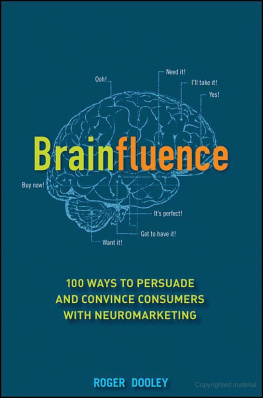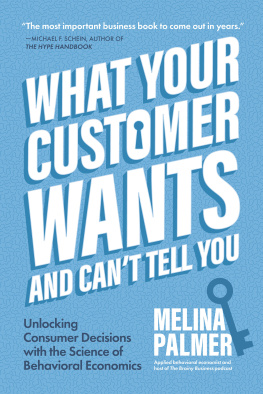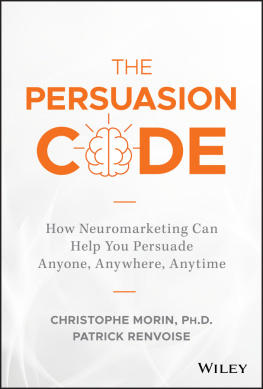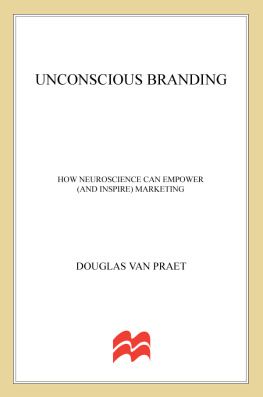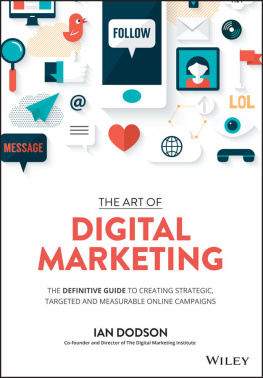Contents

Copyright 2012 by Roger Dooley. All rights reserved.
Published by John Wiley & Sons, Inc., Hoboken, New Jersey.
Published simultaneously in Canada.
No part of this publication may be reproduced, stored in a retrieval system, or transmitted in any form or by any means, electronic, mechanical, photocopying, recording, scanning, or otherwise, except as permitted under Section 107 or 108 of the 1976 United States Copyright Act, without either the prior written permission of the Publisher, or authorization through payment of the appropriate per-copy fee to the Copyright Clearance Center, Inc., 222 Rosewood Drive, Danvers, MA 01923, (978) 750-8400, fax (978) 646-8600, or on the web at www.copyright.com . Requests to the Publisher for permission should be addressed to the Permissions Department, John Wiley & Sons, Inc., 111 River Street, Hoboken, NJ 07030, (201) 748-6011, fax (201) 748-6008, or online at http://www.wiley.com/go/permissions .
Limit of Liability/Disclaimer of Warranty: While the publisher and author have used their best efforts in preparing this book, they make no representations or warranties with respect to the accuracy or completeness of the contents of this book and specifically disclaim any implied warranties of merchantability or fitness for a particular purpose. No warranty may be created or extended by sales representatives or written sales materials. The advice and strategies contained herein may not be suitable for your situation. You should consult with a professional where appropriate. Neither the publisher nor author shall be liable for any loss of profit or any other commercial damages, including but not limited to special, incidental, consequential, or other damages.
For general information on our other products and services or for technical support, please contact our Customer Care Department within the United States at (800) 762-2974, outside the United States at (317) 572-3993 or fax (317) 572-4002.
Wiley publishes in a variety of print and electronic formats and by print-on-demand. Some material included with standard print versions of this book may not be included in e-books or in print-on-demand. If this book refers to media such as a CD or DVD that is not included in the version you purchased, you may download this material at http://booksupport.wiley.com . For more information about Wiley products, visit www.wiley.com .
Library of Congress Cataloging-in-Publication Data:
Dooley, Roger, 1952-
Brainfluence : 100 ways to persuade and convince consumers with neuromarketing / Roger Dooley.
p. cm
ISBN 978-1-118-11336-3 (hardback); ISBN 978-1-118-17594-1 (ebk); ISBN 978-1-118-17595-8 (ebk); ISBN 978-1-118-17596-5 (ebk)
1. Neuromarketing. 2. MarketingPsychological aspects. 3. AdvertisingPsychological aspects. 4. ConsumersPsychology. I. Title.
HF5415.12615.D66 2012
658.80019dc23
2011029938
To Carol, for putting up with me, and to my mother, who sparked my interest in words
Preface
Why Brainfluence?
Todays #1 Challenge: Better Results With Less Money
In these trying economic times, marketers are being called upon to accomplish more, but with fewer resources. Conventional wisdom pairs sales success with the amount of resources you expend. If one out of four sales calls results in a sale, make twice as many calls to double sales. If 10 clicks on a search ad yield one inquiry, on average, then all it takes to up the lead flow is to keep buying more clicks. Need more brand awareness? Buy more ads, sponsor more events, or plaster your logo in more places.
The problem with the more resources applied = more success model is that it gets expensivevery expensive. Worst of all, if the cost of getting a sale isnt justified by the profit from that sale, the model breaks down completely. Applying more resources just results in bigger losses.
The Answer: Appealing to Your Customers Brain
This book is all about smarter marketing. Although there are certainly many ways to boost the effectiveness of your marketing and sales efforts, in Brainfluence well follow one theme: understanding how your customers brains work to get better results with less money.
From Ad Psychology to Neuromarketing
The idea of using our understanding of how people think in marketing and sales is hardly a new idea. No doubt, salespeople in ancient bazaars had some of the same insights into human nature that we have today. And for decades weve seen terms like advertising psychology and sales psychology thrown around in articles and books.
So what has changed since the era depicted in TVs Mad Men? One huge shift is the development of modern neuroscience. For all its accomplishments, traditional psychology treated the brain as a black box. Give a person a stimulus, and you get a response. Even more complex models of how we think (Freuds, for example) were based on observation, experiments, and deduction, but not on a detailed understanding of brain science.
Modern neuroscience has brought us tools that help us see inside our brains and open up psychologys black box. Now, with the magic of functional magnetic resonance imaging (fMRI) brain scans, we can see, for example, that our brains response to a price thats too high is very much like getting pinched: its painful. Electroencephalogram (EEG) technology is bringing the cost of measuring some kinds of brain activity down and allowing larger sample sizes for statistically reliable optimization of ads and products.
How Rational Are We?
We all like to think there are good reasons for what we do and that our decisions result from a conscious, deliberative process. Although certainly there are rational components to many of our decisions and actions, researchers are constantly exposing new ways in which our subconscious drives our choices, often with minimal conscious involvement.
Since the early days of their science, psychologists have suggested that our conscious minds are not in charge of what we do. Freud, for example, developed elaborate theories involving repression and dreams. Many modern scientists attribute behaviors to our evolutionary past. Even as we tweet from our iPhones, evolutionary psychologists say, our brains are operating with software from our hunter-gatherer days.
Not all the new insights come from complex neuroscientific studies. Around the world, behavioral researchers are conducting simple experiments with human subjects that reveal how our brains work and, in some cases, work much differently than we might predict. Duke University professor Dan Ariely is one of these researchers, and if you doubt the existence of unconscious influences on our decisions, read his engaging book, Predictably Irrational .
What Is Neuromarketing?
Ive written the blog titled Neuromarketing since 2005, and I have explored many ways that marketers can use different aspects of brain science to improve results. Theres no universal agreement as to exactly what does (and what doesnt) constitute neuromarketing. Some would use the term to refer only to brain scanbased marketing analysis. Others might add related technologies, such as biometrics (e.g., tracking heart rate and respiration) and eye tracking.
I prefer a broadly inclusive definition of neuromarketing that includes behavioral research and behavior-based strategies. To me, its all a continuum; the reason the fMRI machine shows that your brain lights up at a particular point in a commercial is likely due to some underlying preference or program. The brain scan can show you where the hot button is, but it cant change it or push it.
Neuromarketing is all about understanding how our brains work, regardless of the science used, and employing that understanding to improve both our marketing and our products.
Next page
